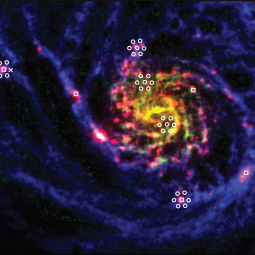By Elizabeth Tarantino and Joan Schmelz
Paper:
Characterizing the Multiphase Origin of [C II] Emission in M101 and NGC 6946 with Velocity-resolved Spectroscopy
Tarantino, Elizabeth, et al., 2021/07, ApJ, 915, 92.
The [C II] fine-structure transition at 158 μm is one of the brightest far-infrared spectral lines, a major coolant of the molecular and atomic gas, and a tracer of star formation in galaxies both nearby and far away. Although observations of [C II] are used routinely as a tool to study gas in galaxies, the interpretation of [C II] data can be complex due to its multi-phase nature. In fact, recent observations from SOFIA in the two nearby spiral galaxies, M101 and NGC 6946, reveal that less than half of the [C II] emission may originate in the molecular gas associated with star formation.
Understanding the cycle between star formation and the interstellar gas is a central question in astronomy. Line-integrated measurements of [C II] are often used to constrain properties of the star-forming processes, such as the molecular gas mass, in nearby galaxies. [C II] is even detected in very distance galaxies using the Atacama Large Millimeter Array (ALMA) when the line is red-shifted into the sub-millimeter band. These results help astronomers investigate the evolution of star formation over cosmic time.
Because the ionization potential of neutral carbon (11.3 eV) is less than that of hydrogen (13.6 eV), significant concentrations of [C II] can exist in neutral (molecular and atomic) and ionized gas. Therefore, to interpret observations of [C II], more information is needed to determine the fraction of emission that originates in each of these components of the interstellar medium.
Researchers used the unique capability of SOFIA/upGREAT to observe [C II] at very high spectral resolution where the profile of the [C II] line is resolved. The shape of the profile traces the bulk motions of gas along the line of sight and, combined with ancillary data, is used to determine which gas phase dominates the [C II] emission. SOFIA observed [C II] and [NII] in 18 different regions across M101 and NGC 6946 that probed a wide range of environments. The [NII] emission is only produced in the ionized gas and can determine the amount of [C II] associated with the ionized phase. Results indicate that the ionized gas contributes no more than 12% to the overall [C II] emission.
VLA HI interferometric and IRAM 30-m CO (2-1) spectra were used as decomposition templates for the atomic and molecular gas, respectively. Careful analysis reveals that the signal-to-noise in the [C II] data needs to be greater than 15 to achieve reliable decomposition results. This requires averaging individual GREAT spectra in regions of common characteristics such as high/low star formation rate and high/low metallicity. This comparison reveals that the molecular and atomic phases each contribute about equally to the [C II] emission on scales of about 500 parsecs. Measurements in the Milky Way and Magellanic Clouds, however, find that the atomic gas has a small (<15%) contribution to the [C II] emission on scales of about three to four parsecs. These results, taken together, suggest that the spatial scale of a measurement has a profound effect on the multi-phase nature of [C II] emission. At larger scales, more diffuse gas is averaged together with star-forming regions, producing a substantial component of [C II] associated with the atomic gas.
Researchers were then able to use the [C II] emission to determine the thermal pressure, an important measurement that can regulate star formation activity in galaxies, in the coldest atomic gas. The resulting values are higher than average thermal pressures measured in outer disk atomic gas regions, likely because the new measurements are able to probe both star-forming and quiescent regions. This shows how SOFIA can be used to determine important physical conditions of interstellar gas in unique ways.
The high proportion of [C II] coming from the atomic gas found in this study suggests that [C II] may be a poor molecular gas tracer. When using [C II] data at near and far redshifts, it is therefore necessary to consider how the multi-phase nature of [C II] emission will affect the analysis.

